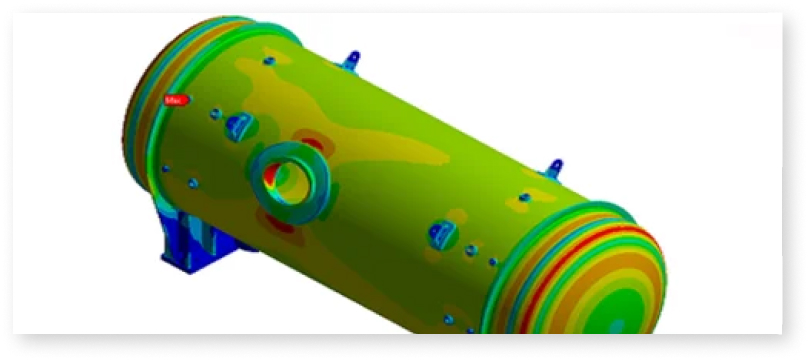Fatigue Analysis Services
Our Fatigue Analysis services ensures long-term reliability and durability, saving you time and costs on maintenance and replacements.
Offerings
Main Menu
Offerings
Main Menu
Fatigue Analysis Services as per ASME Section VIII, Division 2
Our Fatigue Analysis services follow a detailed and systematic approach to predict and prevent failures in equipment subjected to cyclic loading. By complying with ASME Section VIII, Division 2 standards, we ensure the accuracy and reliability of our fatigue assessments for pressure vessels, piping, and critical components. The following steps outline our fatigue analysis process:

Features
Step 1: Screening Criteria for Fatigue Analysis
- Initial Evaluation: The process starts by assessing whether fatigue analysis is necessary based on ASME fatigue screening criteria. If the number of cycles exceeds certain thresholds or if the component is exposed to fluctuating stresses, a detailed fatigue analysis is required.
Step 2: Stress Analysis
- Linear Elastic Stress Analysis:
We perform an elastic stress analysis to calculate the stress distribution in the component. This includes:- Determining Stress Ranges: Calculating stress variations resulting from different load cases (pressure, thermal, and mechanical loads).
- Effective Stress Amplitudes: Evaluating the maximum and minimum stress cycles to predict fatigue damage.
- Elastic-Plastic Stress Analysis (if needed):
For components experiencing high stress, we use an elastic-plastic analysis incorporating cyclic plasticity models, such as multilinear kinematic hardening, to more accurately capture material behavior under repeated loading.
Step 3: Applying Fatigue Design Curves
- ASME Fatigue Curves:
We utilize the ASME Section VIII, Division 2 design fatigue curves, which provide permissible cycles for various stress amplitudes based on material type.
Adjustments are made for factors such as:- Surface Finish and Size Effects: Applying correction factors for surface roughness or geometry that influence fatigue life.
- Temperature Effects: Adjusting fatigue curves for elevated temperature conditions, as required by ASME standards.
Step 4: Cumulative Damage Assessment
- Linear Damage Summation (Miner’s Rule):
We calculate fatigue damage using Miner’s rule, which involves summing up the damage contributions from each stress cycle. The total fatigue damage is evaluated as: D=∑(niNi)D = \sum \left( \frac{n_i}{N_i} \right)D=∑(Nini) where nin_ini is the number of cycles at a given stress range, and NiN_iNi is the allowable number of cycles for that range.
Step 5: Weld Fatigue Assessment (if applicable)
- Structural Stress Method:
For welded joints, we assess fatigue damage at weld toes and other critical locations using structural stress approaches. This involves:- Calculating Equivalent Stress Range: Determining the stress range normal to the potential crack plane, based on the geometry of the weld.
- Post-Weld Heat Treatment Effects: Considering the impact of residual stress relief techniques on fatigue life.
Step 6: Advanced Analysis Techniques
- Multiaxial Fatigue Analysis:
For components subjected to complex loading conditions, we perform multiaxial fatigue analysis to account for combined stress states. - Ratcheting and Shakedown Analysis:
We evaluate progressive deformation under cyclic loading to ensure that the component will not undergo incremental plastic strain accumulation (ratcheting).
Step 7: Life Prediction and Failure Prevention
- Fatigue Life Estimation:
Based on the calculated cumulative damage, we predict the remaining fatigue life of the component. - Recommendations for Design Improvement:
If fatigue damage is significant, we suggest modifications to the component’s design, such as reducing stress concentrations or altering material selection. - Maintenance and Inspection Planning:
We provide actionable insights for maintenance scheduling, ensuring that components are inspected or replaced before fatigue damage reaches critical levels.
Compliance with ASME and Other Standards
Our fatigue analysis is conducted according to ASME Section VIII, Division 2
requirements, while also incorporating insights from PD 5500, EN 13445, and other relevant standards. We ensure that all calculations meet industry safety requirements for pressure vessels and structural components.
Benefits of a Detailed Fatigue Analysis
- Enhanced Safety: Identifying fatigue risks early reduces the likelihood of
unexpected failures. - Optimized Maintenance Scheduling: Enables proactive planning for
inspections and component replacements. - Cost Savings: Prevents unplanned downtime and extends equipment lifespan
through design improvements.